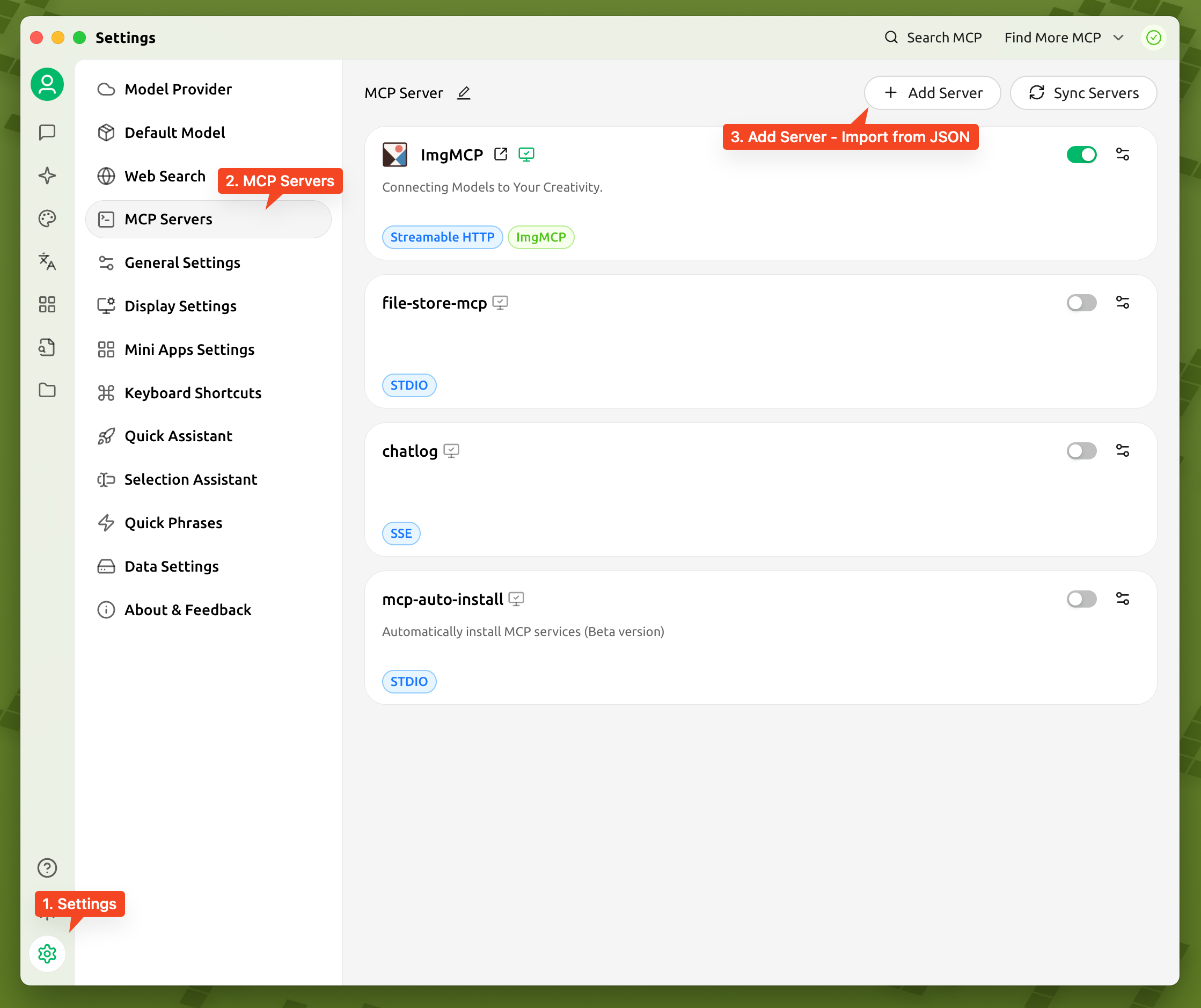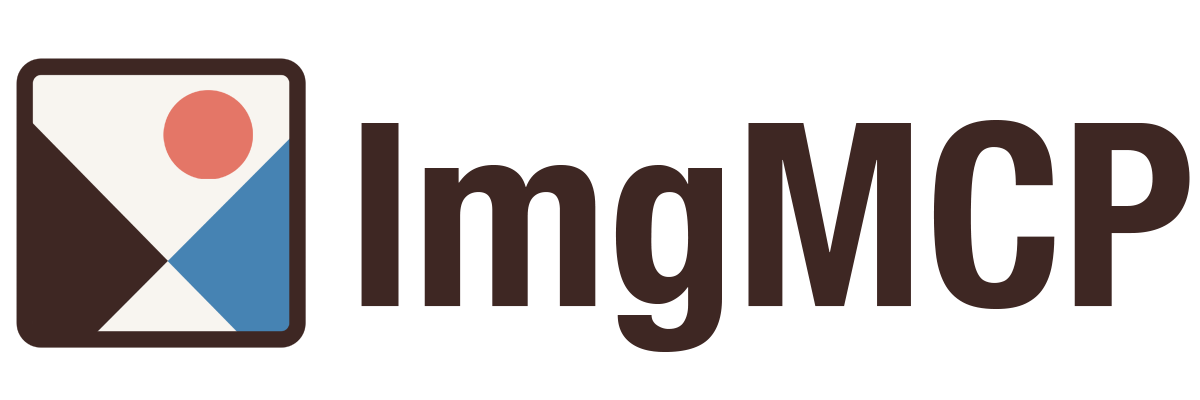ImgMCP
Connecting Models to Your Creativity. We aspire to bring the unique capabilities of AI models to every creative individual, delivering better experiences, lower costs, and higher efficiency. This is the meaning behind our creation of ImgMCP.
README
Introduction
ImgMCP is a multimedia AI model aggregation platform. It aims to provide you with a concise and efficient way to access and utilize various effective multimedia AI models.
We offer a unified API and the MCP (Multimedia Control Protocol) to simplify the model integration process—whether you are integrating them directly into your applications or invoking them via a Large Language Model (LLM).
Our goal is to connect the capabilities of these AI models with your creativity, striving to enhance the experience, reduce costs, and increase efficiency for every creator.
Please consult the relevant documentation here (or in this repository/website) to learn how to leverage ImgMCP's capabilities.
Prerequisites
Before you start using the ImgMCP platform, please ensure you have the following ready:
- An ImgMCP Account: You need to register on the platform. If you don't have an account yet, please go to the Dashboard to register.
- An API Key: An API key is required to authenticate your requests. After registering and logging in, you can find your default API key on the API Keys page in the management console.
Important: Please keep your API key secure and confidential.
Quick Start: Connecting via Streamable HTTP MCP
This section guides you on how to configure an MCP Host (like Cherry Studio) to interact with the ImgMCP platform using our Streamable HTTP MCP Service. This method typically doesn't require installing additional client libraries; you only need to set up the service endpoint and API key.
Supported MCP Hosts:
- Native Support: Tools like Cherry Studio and ChatWise offer a good integration experience with Streamable HTTP MCP.
- Via
mcp-remote: For Hosts that do not yet support the Streamable HTTP protocol (like Claude Desktop or Cursor), you can use the mcp-remote tool as a proxy.
(For detailed configuration guides for different tools, please refer to our dedicated documentation. The following steps use Cherry Studio as an example.)
1. Service Endpoint & Authentication:
-
MCP Endpoint URL:
https://api.imgmcp.com/mcp -
Authentication Method: ImgMCP uses API keys for authentication. Provide the key in the
Authorizationheader of your HTTP requests:Authorization: Bearer <Your API Key> -
Tip: If your MCP Host makes configuring the
Bearer <Your API Key>format difficult, you might try using just<Your API Key>as the value for theAuthorizationheader. However, the standardBearerformat is recommended.
2. Example Configuration in Cherry Studio:
-
Open Cherry Studio and navigate to
Settings -> MCP Servers. -
Click
Add Server, then selectImport from JSON. -
Paste the following JSON content:
{ "name": "ImgMCP", "type": "streamableHttp", "description": "Connecting Models to Your Creativity.", "provider": "ImgMCP", "providerUrl": "https://imgmcp.com", "logoUrl": "https://cdn.imgmcp.com/imgmcp-favicon.png", "baseUrl": "https://api.imgmcp.com/mcp" }
-
After importing, select the newly created "ImgMCP" service.
-
In the
Request Headerssection, add your API key:Authorization=Bearer <Your API Key>(Replace
<Your API Key>with your actual key) -
Click Save.

3. Verify Connection:
After configuration, verify that your MCP Host can communicate with ImgMCP:
-
Basic Check: Check the MCP tool list in your Host (e.g., Cherry Studio). If tools from ImgMCP appear, the basic connection is working.
-
Functional Verification:
- Select an LLM in your Host and enable the ImgMCP toolset.
- Try a simple request, like "Query historical tasks" or ask for the list of available models.
- If the LLM responds with information from ImgMCP (e.g., task history, model list), your setup is successful!

Next Steps:
You've successfully connected your MCP Host! Explore the AI model capabilities offered by ImgMCP.
Available Models
ImgMCP provides access to various AI models via the MCP protocol. Understanding their strengths helps you choose the right tool:
Main Model Types:
- Understanding & General Purpose: Models like
GPT-Image-1excel at interpreting complex descriptions and context, suitable for general image creation from detailed prompts. - Artistic Expression: Models like
Midjourneyare known for strong artistic styles and unique visual effects, ideal for creative exploration. - Professionalism & Stability: Models like
Flux Kontextoffer consistent output for specific applications like product renderings or commercial materials, ensuring predictable results.
Basic Image Processing:
We also integrate fundamental image processing tools:
- Upscaling: Increase image resolution.
- Background Removal: Isolate subjects.
Simplified Invocation via MCP:
Using an MCP-compatible client (like Cherry Studio) with a configured LLM abstracts the complexity. You state your needs in natural language, the LLM parses it, and invokes the appropriate ImgMCP model via MCP. This lets you focus on creativity, not technical details.
Using Styles
Styles in ImgMCP help define or adjust the visual characteristics of generated images quickly.
What are Styles?
A "style" is a set of predefined prompt fragments or parameter combinations designed to influence visual appearance. They often represent common artistic genres (e.g., "watercolor," "cyberpunk"), textures ("claymation," "embroidery"), or lighting ("cinematic lighting," "golden hour").
Benefits of Styles:
- Efficiency: Faster than crafting descriptive prompts from scratch for common effects.
- Consistency: Easily maintain a unified look across multiple creations.
- Inspiration: Browsing the style library can spark new ideas.
Style Library:
We provide a curated library of tested style presets. Use them as a starting point or combine/modify them. You can always define your prompts entirely from scratch as well.
Recommended Servers
playwright-mcp
A Model Context Protocol server that enables LLMs to interact with web pages through structured accessibility snapshots without requiring vision models or screenshots.
Magic Component Platform (MCP)
An AI-powered tool that generates modern UI components from natural language descriptions, integrating with popular IDEs to streamline UI development workflow.
Audiense Insights MCP Server
Enables interaction with Audiense Insights accounts via the Model Context Protocol, facilitating the extraction and analysis of marketing insights and audience data including demographics, behavior, and influencer engagement.
VeyraX MCP
Single MCP tool to connect all your favorite tools: Gmail, Calendar and 40 more.
graphlit-mcp-server
The Model Context Protocol (MCP) Server enables integration between MCP clients and the Graphlit service. Ingest anything from Slack to Gmail to podcast feeds, in addition to web crawling, into a Graphlit project - and then retrieve relevant contents from the MCP client.
Kagi MCP Server
An MCP server that integrates Kagi search capabilities with Claude AI, enabling Claude to perform real-time web searches when answering questions that require up-to-date information.
E2B
Using MCP to run code via e2b.
Neon Database
MCP server for interacting with Neon Management API and databases
Exa Search
A Model Context Protocol (MCP) server lets AI assistants like Claude use the Exa AI Search API for web searches. This setup allows AI models to get real-time web information in a safe and controlled way.
Qdrant Server
This repository is an example of how to create a MCP server for Qdrant, a vector search engine.
